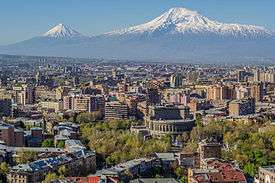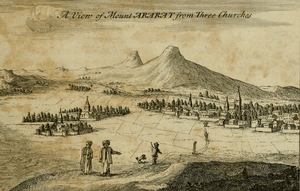Mount Ararat
| Mount Ararat | |
|---|---|
|
| |
| Highest point | |
| Elevation |
5,137 m (16,854 ft) See Elevation section |
| Prominence |
3,611 m (11,847 ft) Ranked 48th |
| Parent peak | Mount Damavand[1] |
| Listing |
Country high point Ultra |
| Coordinates | 39°42.113′N 44°17.899′E / 39.701883°N 44.298317°ECoordinates: 39°42.113′N 44°17.899′E / 39.701883°N 44.298317°E [2] |
| Geography | |
 Mount Ararat Location in Turkey | |
| Location | Iğdır Province (65%)[3] and Ağrı Province, Turkey[lower-alpha 1] |
| Parent range | Armenian Highlands |
| Geology | |
| Mountain type | Stratovolcano |
| Last eruption | 1840[5] |
| Climbing | |
| First ascent |
9 October [O.S. 27 September] 1829 Friedrich Parrot, Khachatur Abovian, two Russian soldiers, two Armenian villagers |
Mount Ararat (/ˈɑːrəˌrɑːt/ ar-UH-rat;[6][7] Turkish: Ağrı Dağı; traditional Armenian: Մասիս, Masis) is a snow-capped and dormant compound volcano in the eastern extremity of Turkey.[8] It consists of two major volcanic cones: Greater Ararat, the highest peak in Turkey and the Armenian plateau with an elevation of 5,137 m (16,854 ft); and Lesser Ararat, with an elevation of 3,896 m (12,782 ft).[9] The Ararat massif is about 40 km (25 mi) in diameter.
Mount Ararat is associated with the "mountains of Ararat" in the Bible. It is the traditional resting place of Noah's Ark according to the Book of Genesis. It is the main[10] national symbol of Armenia and is considered a "holy mountain" by Armenians.[11][12] One author described the Armenians as having "a sense of possession of Ararat in the sense of symbolic cultural property."[13] It is featured prominently in Armenian literature and art. Along with Noah's Ark, it is depicted on the coat of arms of Armenia.
The first efforts to reach Ararat's summit were made in the Middle Ages. However, it was not until 1829 when Friedrich Parrot and Khachatur Abovian, accompanied with four others, made the first recorded ascent.
Political borders
Mount Ararat forms a near-quadripoint between Turkey, Armenia, Azerbaijan and Iran. Its summit is located some 16 km (10 mi) west of both the Iranian border and the border of the Nakhchivan exclave of Azerbaijan, and 32 km (20 mi) south of the Armenian border. The Turkish-Armenian-Azerbaijani and Turkish-Iranian-Azerbaijani tripoints are some 8 km apart, separated by a narrow strip of Turkish territory containing the E99 road which enters Nakhchivan at 39°39′19″N 44°48′12″E / 39.6553°N 44.8034°E.
The international boundaries as described have been in effect since the dissolution of the Soviet Union and the independence of Armenia and Azerbaijan. However, they have a longer history, having been drawn in 1921, after the conflicts of World War I and the dissolution of the Ottoman Empire that affected the region. The mountain came under Turkish control during the 1920 Turkish–Armenian War.[14] It formally became part of Turkey according to the 1921 Treaty of Kars.[15] By the Tehran Convention of 1932, a border change was made in Turkey's favor, allowing it to occupy the eastern flank of Lesser Ararat.[16] The Iran-Turkey boundary skirts east of Lesser Ararat, the lower peak of the Ararat massif.
Names and etymology
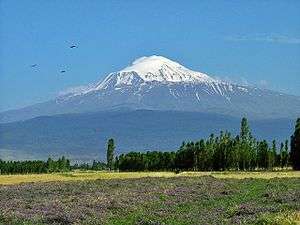
The term Ararat (Hebrew: אֲרָרָט; Armenian: Արարատ) derives from the Hebrew name of the ancient kingdom of Urartu.[17] The mountain is known as Ararat in European languages.[18] However, none of the native peoples have traditionally referred to the mountain by that name. This was noted by James Bryce in 1876.[19]
The traditional Armenian name is Masis (Մասիս [maˈsis]), which is sometimes transliterated as Massis. The plural Masikʿ(Մասիք [maˈsikʰ]) may refer to both peaks.[20] The folk etymology expressed in Movses Khorenatsi's History of Armenia derives the name from a king Amasya, the great-grandson of the legendary Armenian patriarch Hayk, who is said to have called the mountain Masis after himself.[20] According to Russian orientalist Anatoly Novoseltsev the word Masis derives from Persian (Farsi) and means "great" and "large". In Middle Persian masist meant "[the] largest".[21] Nowadays, the terms Masis and Ararat are both widely, often interchangeably, used in Armenian.[22][23]
The Turkish name is Ağrı Dağı [ɑːrɯ dɑ.ɯ], Ottoman Turkish: اغـر طﺎﻍ Ağır Dağ), i.e. "Mountain of Ağrı". Ağrı literally translates to "pain" or "sorrow".[21][24][25] This name has been known since the late Middle Ages.[21] Ağrı is also a province in eastern Turkey, which was officially renamed for the mountain in 1949.[26]
The Persian name is کوه نوح, [ˈkuːhe ˈnuːh], Kūh-e Nūḥ,[27] literally the "mountain of Noah".[28]
The Kurdish names are Çiyayê Agirî[29][30] [t͡ʃɪjaːˈje aːgɪˈriː] ("Fiery Mountain") or Grîdax [griːˈdaːx].
The mountains ’Áβος, Abos and Νίβαρος, Nibaros mentioned in Strabo's Geographica are believed by some scholars, such as Nicholas Adontz[31] and Vladimir Minorsky,[32] to be the two peaks of Ararat.
Geography
Mount Ararat is located in the Eastern Anatolia Region of Turkey between Doğubeyazıt and Iğdır, near the border with Iran, Armenia and Nakhchivan exclave of Azerbaijan, between the Aras and Murat rivers.[4] Its summit is located some 16 km (10 mi) west of the Turkey-Iran border and 32 km (20 mi) south of the Turco-Armenian border. The Ararat plain runs along its northwest to western side.
Elevation
An elevation of 5,165 m (16,946 ft) for Mount Ararat is still given by some authorities. However, a number of other sources, such as public domain and verifiable Shuttle Radar Topography Mission (STRM) data[33] and a 2007 GPS measurement show that the alternatively widespread figure of 5,137 m (16,854 ft) is probably more accurate, and that the true elevation may be even lower due to the thick layer of snow-covered ice cap which permanently remains on the top of the mountain. 5,137 m is also supported by numerous topographic maps.[34]
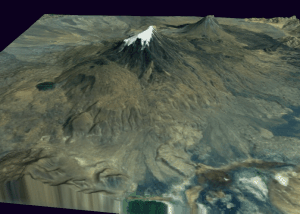
Summit Ice Cap
Mount Ararat has an ice cap on its summit. Since at least about 1957, it has been shrinking. In the late 1950s, Blumenthal[35] observed that there existed 11 outlet glaciers emerging from a summit snow mass that covered about 10 km2 (3.9 sq mi). At that time, it was found that the present glaciers on the summit of Ararat to extend as low as an elevation of 3,900 meters (12,800 ft) on the north-facing slope, and an elevation of 4,200 meters (13,800 ft) on its south-facing slope.[35] Using pre-existing aerial imagery and remote sensing data, Sarıkaya[29][36] and others studied the extent of the ice cap on Mount Ararat between 1976 and 2011. They discovered that this ice cap had shrank to 8.0 km2 (3.1 sq mi) by 1976 and to 5.7 km2 (2.2 sq mi) by 2011. They calculated that between 1976 and 2011, the ice cap on top of Mount Ararat had lost 29% of its total area at an average rate of ice loss of 0.07 km2 (0.027 sq mi) per year over 35 years. This rate is consistent with the general rates of retreat of other Turkish summit glaciers and ice caps that have been documented by other studies.[36]
Blumenthal[35] estimated that the snow line had been as low as 3,000 meters (9,800 ft) in elevation during the Late Pleistocene. Such a snow line would have created an ice cap of 100 km2 (39 sq mi) in extent. However, he observed a lack of any clear evidence of prehistoric moraines other than those which were close to the 1958 glacier tongues. Blumenthal explained the absence of such moraines by the lack of confining ridges to control glaciers, insufficient debris load in the ice to form moraines, and their burial by later eruptions. Years later, Birman[37] observed on the south-facing slopes a possible moraine that extends at least 300 meters (980 ft) in altitude below the base of the 1958 ice cap at an elevation of 4,200 meters (13,800 ft). He also found two morainal deposits that were created by a Mount Ararat valley glacier of Pleistocene, possibly Wisconsinan (Last Glacial Maximum) age downvalley from Lake Balik Golu. The higher moraine lies at an altitude of about 2,200 meters (7,200 ft) and the lower moraine lies at an altitude of about 1,800 meters (5,900 ft). The lower moraine occurs about 15 kilometers (9.3 mi) downstream from Lake Balik Golu. Both moraines are about 30 meters (98 ft) high. It is suspected that Lake Balik Golu occupies a glacial basin.[37]
Geology
Mount Ararat is a polygenic, compound stratovolcano. Covering an area of 1,100 km2 (420 sq mi), it is the largest volcanic edifice within the region. Along its northwest–southeast trending long axis, Mount Ararat is about 45 kilometers (28 mi) long and is about 30 kilometers (19 mi) long along its short axis. It consists of about 1,150 km3 (280 cu mi) of dacitic and rhyolitic pyroclastic debris and dacitic, rhyolitic, and basaltic lavas.[9]
Mount Ararat consists of two distinct volcanic cones, Greater Ararat and Lesser Ararat (Little Ararat). The western volcanic cone, Greater Ararat, is a steep-sided volcanic cone that is larger and higher than the eastern volcanic cone. Greater Ararat is about 25 kilometers (16 mi) wide at the base and rises about 3 kilometers (1.9 mi) above the adjacent floors of the Iğdir and Doğubeyazıt basins. The eastern volcanic cone, Lesser Ararat, is 3,896 meters (12,782 ft) high and 15 kilometers (9.3 mi) across. These volcanic cones, which lie 13 kilometers (8.1 mi) apart, are separated by a wide north–south-trending crack. This crack is the surface expression of an extensional fault. Numerous parasitic cones and lava domes have been built by flank eruptions along this fault and on the flanks of both of the main volcanic cones.[9]
Mount Ararat lies within a complex, sinistral pull-apart basin that originally was a single, continuous depression. The growth of Mount Ararat partitioned this depression into two smaller basins, the Iğdir and Doğubeyazıt basins. This pull-apart basin is the result of strike-slip movement along two en-echelon fault segments, the Doğubeyazıt–Gürbulak and Iğdir faults, of a sinistral strike–slip fault system. Tension between these faults, not only formed the original pull-apart basin, but created a system of faults, exhibiting a horsetail splay pattern, that control the position of the principal volcanic eruption centers of Mount Ararat and associated linear belt of parasitic volcanic cones. The strike-slip fault system within which Mount Ararat located is the result of north–south convergence and tectonic compression between the Arabian Platform and Laurasia that continued after the Tethys Ocean closed during the Eocene epoch along the Bitlis–Zagros suture.[9][38][39]
Geological history
During the early Eocene and early Miocene, the collision of Arabian platform with Laurasia closed and eliminated the Tethys Ocean from the area of what is now Anatolia. The closure of these masses of continental crust, collapsed this ocean basin by middle Eocene and resulted in a progressively shallowing of the remnant seas, until the end of early Miocene period. Post-collisional tectonic convergence within the collision zone resulted in the total elimination of the remaining seas from East Anatolia, at the end of early Miocene, crustal shortening and thickening across the collision zone, and uplift of the East Anatolian–Iranian plateau. Accompanying this uplift was extensive deformation by faulting and folding, which resulted in the creation of numerous local basins. The north–south compressional deformation continues today as evidenced by ongoing faulting, volcanism, and seismicity.[9][38][40]
Within Anatolia, regional volcanism started middle-late Miocene. During the late Miocene–Pliocene period, widespread volcanism blanketed the entire East Anatolian–Iranian plateau under thick volcanic rocks. This volcanic activity has continued uninterrupted until historical times. Apparently, it reached a climax during the latest Miocene–Pliocene, 6 to 3 Ma. During the Quaternary, the volcanism became restricted to a few local volcanoes such as Mount Ararat. These volcanoes are typically associated with north–south tensional fractures formed by the continuing the north–south shortening deformation of Anatolia.[9]
In their detailed study and summary of the Quaternary volcanism of Anatolia, Yilmaz[9] and others recognized four phases to the construction of Mount Ararat from volcanic rocks exposed in glacial valleys deeply carved into it flanks. First, they recognized a fissure eruption phase of Plinian-subPlinian fissure eruptions that deposited more than 700 meters (2,300 ft) of pyroclastic rocks and a few basaltic lava flows. These volcanic rocks were erupted from approximately north northwest–south southeast-trending extensional faults and fissures prior to the development of Mount Ararat. Second, a cone-building phase began when the volcanic activity became localized at a point along a fissure. During this phase, the eruption of successive flows of lava up to 150 meters (490 ft) thick and pyroclastic flows of andesite and dacite composition and the following eruption of basaltic lava flows, formed the Greater Ararat cone with a low conical profile. Third, during a climatic phase, copious flows of andesitic and basaltic lavas were erupted. During this phase, the current cones of Greater and Lesser Ararat were formed as eruptions along subsidiary fissures and cracks and flank occurred. Finally, the volcanic eruptions at Mount Ararat transitioned into a flank eruption phase during which a major north–south-trending fault offset the two cones developed along with a number of number of subsidiary fissures and cracks on the volcano's flanks. Along this fault and the subsidiary fissures and cracks, a number of parasitic cones and domes were built by minor eruptions. One subsidiary cone erupted voluminous basalt and andesite lava flows. They flowed across the Doğubeyazıt plain and along the southerly flowing Sarısu River. These lava flows formed black ʻaʻā and pāhoehoe lava flows that contain well preserved lava tubes.[9] The radiometric dating of these lava flows yielded radiometric ages of 0.4, 0.48 and 0.81 Ma.[41] Overall, radiometric ages obtained from the volcanic rocks erupted by Mount Ararat range from 1.5 to 0.02 Ma.[9]
Recent volcanic and seismic activity
The chronology of Holocene volcanic activity associated with Mount Ararat is poorly documented. However, either archaeological excavations, oral history, historical records, or combination of these data provide solid evidence that volcanic eruptions of Mount Ararat occurred in 2500–2400 BC, 550 BC, possibly in 1450 AD and 1783 AD, and definitely in 1840 AD. Archaeological evidence demonstrates that explosive eruptions and pyroclastic flows from the northwest flank of Mount Ararat destroyed and buried at least one Koura–Arax culture settlement and caused numerous fatalities in 2500–2400 BC. Oral histories indicated that a significant eruption of uncertain magitude occurred in 550 BC and minor eruptions of uncertain nature might have occurred in 1450 AD and 1783 AD.[5][39][40][42] According to the interpretation of historical and archaeological data, strong earthquakes not associated with volcanic eruptions also occurred the area of Mount Ararat in 139, 368, 851–893, and 1319 AD. During the 139 AD earthquake, a large landslide that caused many casualties and was similar to the 1840 AD landslide originated from the summit of Mount Ararat.[39][40][43]
- 1840 eruption
Historical records and oral history document a phreatic eruption and pyroclastic flow from radial fissures on the upper north flank of Mount Ararat and a possibly associated earthquake of magnitude 7.4 that caused severe damage and numerous casualties in 1840 AD. Up to 10,000 people in the Mount Ararart region died in the earthquake, including 1900 villagers in the village of Akory who were killed by a gigantic landslide and subsequent debris flow. In addition, this combination of landslide and debris flow destroyed the town of Aralik, several villages, and Russian military barracks. It also temporarily dammed the Sevjour River.[5][39][40][42]
Ascents
The 13th century missionary William of Rubruck wrote that "Many have tried to climb it, but none has been able."[44]
First ascent
The first recorded ascent of the mountain in the modern times took place on 9 October [O.S. 27 September] 1829.[45][46][47] The Baltic German naturalist Friedrich Parrot of the University of Dorpat arrived at Etchmiadzin in mid-September 1829, almost two years after Russian capture of Erivan, for the single purpose of exploring Ararat. The prominent Armenian writer Khachatur Abovian, then a deacon and translator at Etchmiadzin, was assigned by Catholicos Yeprem, the head of the Armenian Church, as interpreter and guide. Abovian and Parrot crossed the Aras River and headed to the Armenian village of Agori situated on the northern slope of Ararat 1,220 metres (4,000 ft) above sea level. They set up a base camp at the Monastery of Saint Jacob some 730 metres (2,400 ft) higher, at an elevation of 1,943 metres (6,375 ft). After two failed attempts, they reached the summit on their third attempt at 3:15 p.m. on October 9, 1829.[45][48] The group included Parrot, Abovian, two Russian (Cossack) soldiers—Alexei Zdorovenko and Matvei Chalpanov, and two Armenian Agori villagers—Hovannes Aivazian, and Murat Poghossian.[48][49] Parrot measured the elevation at 5,250 metres (17,220 ft) using a mercury barometer. This was not only the first ascent of Ararat, but also the second highest elevation climbed by man up to that date outside of Mount Licancabur in the Chilean Andes. Abovian dug a hole in the ice and erected a wooden cross facing north. Abovian also picked up a chunk of ice from the summit and carried it down with him in a bottle, considering the water holy. On 8 November [O.S. 27 October] 1829, Parrot and Abovian together with the Agori hunter Sahak’s brother Hago, acting as a guide climbed up Lesser Ararat.[48]
Later notable ascents
| Wikisource has original text related to this article: |
Other early notable climbers of Ararat included Russian climatologist and meteorologist Kozma Spassky-Avtonomov (August 1834), Karl Behrens (1835), German mineralogist and geologist Otto Wilhelm Hermann von Abich (29 July 1845),[50] British politician Henry Danby Seymour (1848).[51] Later in the 19th century, two British scholars on Armenia—James Bryce (1879)[52] and H. F. B. Lynch (1893)[53][54]—climbed the mountain. The first winter climb was by Bozkurt Ergör, the former president of the Turkish Mountaineering Federation, who climbed on 21 February 1970.[55]
Resting place of Noah's Ark
Origins of the tradition
| Genesis 8:4 in different versions of the Bible | ||||||||||||||||||||||||||||
|---|---|---|---|---|---|---|---|---|---|---|---|---|---|---|---|---|---|---|---|---|---|---|---|---|---|---|---|---|
| ||||||||||||||||||||||||||||
_-_topographia_paradisi.jpg)
_Topographia_paradisi.jpg)
According to the fourth verse of the eighth chapter of the Book of Genesis (Genesis 8:4) Noah's Ark landed on the "mountains of Ararat" following a flood. Most historians and Bible scholars agree that "Ararat" is the Hebrew name of Urartu, the geographic predecessor of Armenia, and did not, at the time, only refer to Mount Ararat.[lower-alpha 2] Nevertheless, Mount Ararat is considered the traditional site of the resting place of the Noah's Ark and most Christians prefer this view.[61] It has therefore been called a biblical mountain.[62][63][64][65][66]
According to Arnold, Mount Ararat has been associated with the Genesis flood story since the 11-12th centuries.[59] Bailey suggested that the local Armenian population began to identify it as the ark's landing place in the 11-12th centuries.[67] British orientalist F. C. Conybeare in his 1901 review of Friedrich Murad's book on Ararat wrote that the mountain was "a center and focus of pagan myths and cults [...] and it was only in the eleventh century, after these had vanished from the popular mind, that the Armenian theologians ventured to locate on its eternal snows the resting-place of Noah's ark."[68] Fischer[58] and Spencer & Lienard[69] name the 13th century Franciscan missionary William of Rubruck as the earliest reference for the tradition of Mount Ararat as the landing place of the ark in European literature.[44]
"...the Biblical passage only goes to this, that the Ark rested upon a mountain in the district which the Hebrews knew as Ararat, or Armenia. At the same time our mountain is so very much higher, more conspicuous, and more majestic than any other summit in Armenia, that one could hardly doubt that if the Biblical writer had any particular mountain present to his mind, it must have been our Mount Ararat."
- Prevalence
American Christian missionary Harrison Gray Otis Dwight wrote in 1856 that "the general opinion of the learned in Europe" is that Noah's Ark rested on Mount Ararat.[70] According to the Catholic Encyclopedia (1907), both Jewish and Armenian tradition say Noah's Ark rested on Mount Ararat.[71] Spencer and Lienard wrote in 2005 that Mount Ararat is where the European tradition and most of Western Christianity place the landing of Noah's Ark and add that the tradition "seems to be well entrenched in the Christian world."[69] During his visit to Armenia in 2001 Pope John Paul II declared in his homily: "We are close to Mount Ararat, where tradition says that the Ark of Noah came to rest."[72] Patriarch Kirill of Moscow, the head of the Russian Orthodox Church, also mentioned Mount Ararat as the resting place of Noah's Ark in his speech at the Etchmiadzin Cathedral during his visit to Armenia in 2010.[73]
Searches
Traditionally, Mount Ararat has been one of the major locations for searches for Noah's Ark. Despite numerous reports of ark sightings (e.g. Ararat anomaly) and rumors, "no scientific evidence of the ark has emerged."[74] Searches for Noah's Ark are considered by scholars an example of pseudoarchaeology.[75][76] Kenneth Feder writes, "As the flood story itself is unsupported by any archaeological evidence, it is not surprising that there is no archaeological evidence for the existence of an impossibly large boat dating to 5,000 years ago."[77]
Significance among Armenians

Mount Ararat is widely considered a national symbol of Armenia.[11][12][80] Due to its association with the Biblical flood story,[81] it known as the "holy mountain" of the Armenian people.[12][15][82][83] Mount Ararat, a critical piece of the Armenian homeland,[84] was the geographical center of the ancient Armenian kingdoms.[85][86] According to Shirinian, in the 19th century when an Armenian state did not exist, Mt. Ararat symbolized the historical Armenian nation-state.[87] The 1918–20 Republic of Armenia, the first modern Armenian state, was sometimes called the "Araratian Republic" or the "Republic of Ararat".[88][89][90]
- Myth of origin
The Genesis flood narrative was linked to the Armenian myth of origin by the early medieval historian Movses Khorenatsi. In his History of Armenia, Khorenatsi wrote that Hayk, the legendary founding father and the name giver of the Armenian people is the son of Torgom, the great-grandson of Japheth, one of Noah's sons.[91] Hayk established the roots of the Armenian nation around Mount Ararat.[92] This myth has several powerful symbolic components. Razmik Panossian suggested that the story "makes Armenia the cradle of all civilisation since Noah’s Ark landed on the ‘Armenian’ mountain of Ararat. [...] it connects Armenians to the biblical narrative of human development. [...] it makes Mount Ararat the national symbol of all Armenians, and the territory around it the Armenian homeland from time immemorial."[93]
- Symbol of genocide and "lost lands"
In the aftermath of the Armenian Genocide of 1915, a large portion of the Armenian homeland, particularly what is now eastern Turkey, was left with little to no Armenian population. Although Ararat was part of the Russian Empire's Erivan Governorate and was ceded to Turkey by the 1921 Treaty of Kars, in the later decades it came to represent the loss of Western Armenia (eastern Turkey) in the national consciousness of the Armenians.[94][95][lower-alpha 3] "[I]t looms as a reminder of the tragedy that has dominated Armenian life: Mount Ararat is visible from Armenia, but it belongs to Turkey."[96] Ararat has become a symbol of Armenian efforts to reclaim its "lost lands", i.e. the areas west of Ararat that are now part of Turkey that had significant Armenian population before the genocide.[97]
- Modern symbolism
Armenian scholar Hamlet Petrosyan wrote: "The mountain has become, for all intents and purposes, the calling card of Armenia."[98] Russian online newspaper Lenta.ru described Ararat as the main brand of Armenia.[99] Turkish newspaper Radikal described Ararat "more than a mountain" for Armenians.[100] US President Herbert Hoover, who was the head of the Food Administration during World War I, wrote in his memoirs that the association of Mount Ararat and Noah, among other things, "cumulated to impress the name of Armenia on the American mind."[lower-alpha 4]
- Coat of arms of Armenia
Mount Ararat has been depicted on the coat of arms of Armenia consistently since 1918. The First Republic's coat of arms was designed by architect Alexander Tamanian and painter Hakob Kojoyan. This coat of arms was adopted by the legislature of the Republic of Armenia on April 19, 1992, after Armenia regained independence. Ararat is depicted along with the ark on its peak on the shield on an orange background.[103]
The emblem of the Armenian Soviet Socialist Republic (Soviet Armenia) was created by the prominent painter Martiros Saryan and Kojoyan in 1921.[104] Mount Ararat is depicted in the middle and makes up a large portion of it.
 First Republic (1918-20) |
 Soviet Republic (1921–91) |
 Current Republic (1992-) |
Territorial claims
"In most Armenian homes in the modern diaspora, there are pictures of Mount Ararat, a bittersweet reminder of the homeland and national aspirations. Although the mountain is in Turkey, it remains for Armenians a symbol of hope because it is the place where the Bible says Noah's ark came to rest."

The nationalist Armenian Revolutionary Federation (Dashnaktsutyun) party claims eastern Turkey (Western Armenia) as part of United Armenia.[107][108] The government of the Republic of Armenia has never made claims to any Turkish territory,[109] however the Armenian government has avoided "an explicit and formal recognition of the existing Turkish-Armenian border."[110] According to Turkish scholar Bayram Balci regular references to the Armenian Genocide and Mount Ararat "clearly indicates that the border with their eastern neighbour in contested."[111]
In a 2010 interview with Der Spiegel, Armenian President Serzh Sargsyan was asked: "You can see Mount Ararat, Armenia's national symbol, from the windows of your residence. Today, the mountain is inaccessible, on the other side of the Turkish border. Turkey fears demands for land and compensation. Do you want Mount Ararat back?" Sargsyan, in response, said:[112]
No one can take Mount Ararat from us; we keep it in our hearts. Wherever Armenians live in the world today, you will find a picture of Mount Ararat in their homes. And I feel certain that a time will come when Mount Ararat is no longer a symbol of the separation between our peoples, but an emblem of understanding. But let me make this clear: Never has a representative of Armenia made territorial demands. Turkey alleges this—perhaps out of its own bad conscience?
In various settings, several notable individuals have spoken in support of Armenian claims over Mt. Ararat. German historian Tessa Hofmann, for example, suggested that "the return of the ruins of Ani and of Mount Ararat [by Turkey to Armenia], both in the immediate border area could be considered as a convincing gesture of Turkey’s apologies and will for reconciliation."[113] Slovak conservative politician František Mikloško stated at a conference on Turkey's foreign policy in Poland in 2010: "Mount Ararat [represents the] Christian heritage of Armenians. Does modern Turkey consider the possibility of giving the mount back to Armenians? The return of Ararat would be an unprecedented step to signify Turkey’s willingness to build a peaceful future and promote its image at the international scene."[114] Lithuanian political scientist and Soviet dissident Aleksandras Štromas wrote: "The Armenians would also be right to claim from Turkey the Ararat Valley, which is an indivisible part of the Armenian homeland containing the main spiritual center and supreme symbol of Armenia's nationhood, the holy Mountain of Ararat itself."[115]
In popular culture
- In music
The 8th track of the album Hypnotize (2005) by System of a Down, an American rock band composed of four Armenian Americans, "references Mount Ararat [...] and details that the souls lost to the Armenian Genocide have returned to rest here."[116]

- Stamps
After independence from the Soviet Union, Armenia issued first of its three stamps in 1992. All three depicted Mt. Ararat.[117]
- Sports
Mount Ararat is depicted on the logo of the Football Federation of Armenia. There are football (soccer) teams based in Yerevan, Armenia (FC Ararat Yerevan) and Tehran, Iran (F.C. Ararat Tehran)
- In film
The 2002 film Ararat by Armenian-Canadian filmmaker Atom Egoyan features Mt. Ararat prominently in its symbolism.
- Press
The official newspaper of the Social Democrat Hunchakian Party in Lebanon (Ararad daily) and California (Massis weekly) are both named for Ararat.
- On banknotes
Mount Ararat was depicted on various Armenian dram banknotes issued in 1993-2001; on the reverse of the 10 dram banknotes issued in 1993, on the reverse of the 50 dram banknotes issued in 1998, on the obverse of the 100 and 500 dram banknotes issued in 1993, and on the reverse of the 50,000 dram banknotes issued in 2001.
And on the reverse of the Turkish 100 lira banknotes of 1972-1986.[lower-alpha 5]
In art
- European
Ararat was depicted in the books of European, including many British, and American travelers in the 19th century who visited Armenia.
-

Robert Ker Porter, 1821
-
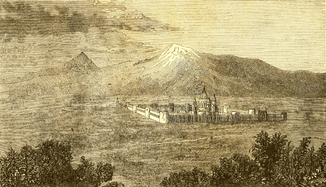
"View of Ararat and the Monastery of Echmiadzin", from the 1846 English translation of Friedrich Parrot's Journey to Ararat
-
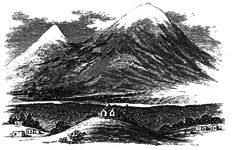
Justin Perkins, 1861
-

James Bryce, 1877
-
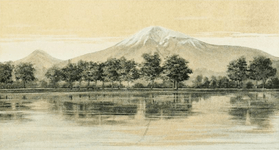
H. F. B. Lynch, 1901
- Armenian
The first Armenian artist to depict the mountain was Ivan Aivazovsky,[118] who created a painting of Ararat during his visit to Armenia in 1868.[119] Other major Armenians artists who painted Ararat include Yeghishe Tadevosyan, Gevorg Bashinjaghian, Martiros Saryan,[120] and Panos Terlemezian.
-

Mkrtum Hovnatanian, 1836
-
.jpg)
Ivan Aivazovsky, Valley of Mount Ararat, 1882
-
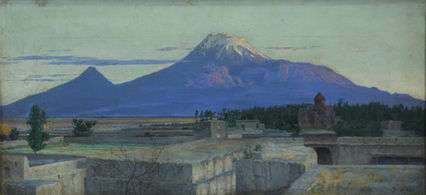
Yeghishe Tadevosyan, Ararat from Ejmiatsin, 1895
-
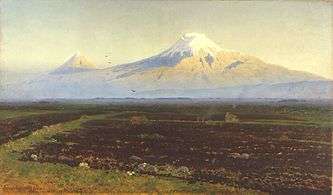
Gevorg Bashinjaghian, 1912
-
.jpg)
Panos Terlemezian, 1929
In literature
William Wordsworth imagines seeing the ark[121] in the poem "Sky-Prospect":[122]
- Lo! in the burning west, the craggy nape
- Of a proud Ararat! and thereupon,
- The Ark, her melancholy voyage done!
Meliné Karakashian described the significance of Mt. Ararat in Armenian literature: "Numerous poets have written about the majestic Mt. Ararat, which is presently located in Turkey, yet clearly visible from Armenia. The symbolic significance of Mt. Ararat cannot be underestimated. Poets identify with the permanence of the mountain and garner strength from it. They attribute to it symbolic meanings of unity, freedom, and independence."[123]
The last two lines of Yeghishe Charents's 1920 poem "I Love My Armenia" (Ես իմ անուշ Հայաստանի) read:[124]
- And in the entire world you will not find a mountaintop like Ararat's.
- Like an unreachable peak of glory I love my Mount Masis.
Mount Ararat is the most frequently cited symbol in the poetry of Hovhannes Shiraz (1914–84). According to Bardakjian, Ararat "epitomizes Armenia and Armenian suffering and aspirations, especially the consequences of the 1915 genocide: almost total annihilation, loss of a unique culture and land (including cities such as Ani and Van), and an implicit determination never to recognize the new political borders."[125] In collection of poems, Knar Hayastani (Lyre of Armenia) published in 1958, there are many poems "with very strong nationalist overtones, especially with respect to Mount Ararat (in Turkey) and the irredentism it entailed." One such poem, "Ktak" (Bequest), reads:[126]
- My son, what should I bequeath you? what should I bequeath, my boy?
- …
- I want to will you such a treasure as a father,
- That no other father can will you in another country,
- …
- I will bequeath you our mountain, that you take it out of black clouds,
- So you bring it home [based on] pure justice,
- …
- I am willing you Masis, that you keep it forever,
- As the language of us Armenians, as the pillar of your father’s home.
The first three lines of Paruyr Sevak's 1961 poem "We Are Few..." (Քիչ ենք, բայց հայ ենք) read:[127]
- We are few, but they say of us we are Armenians.
- We do not think ourselves superior to anyone.
- Clearly we shall have to accept
- That we, and only we, have an Ararat
In one short poem Silva Kaputikyan compares Armenia to an "ancient rock-carved fortress", the towers of which are Mount Aragats and Moun Ararat.
Places named for Ararat
In Armenia, there is a province, two cities (Ararat, Masis), and two villages (Ararat, Masis) named Ararat.
In the United States, an unincorporated community in North Carolina, a township and mountain in Pennsylvania, and a river in Virginia and North Carolina are named Ararat.
In the Australian state of Victoria, there is a city and a rural city named Ararat.
Gallery
-
taken from the International Space Station on 8 July 2011
-
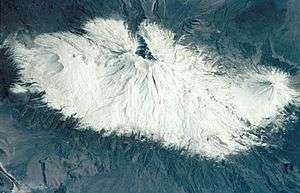
taken from the Space Shuttle on 18 March 2001
-
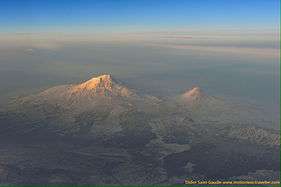
-
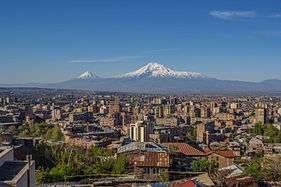
View from Yerevan
-

-

View of Ararat from Khor Virap, Armenia
-

from Turkey
-
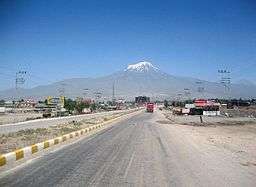
from Doğubeyazıt
-

from Iğdır
-

from Nakhchivan
See also
References
- Notes
- ↑ The only permitted route to climb Mount Ararat begins in Doğubeyazıt, optionally by automobile. Ministry of Culture and Tourism (2005).[4]
- ↑
- Richard James Fischer: "The Genesis text, using the plural "mountains" (or hills), identifies no particular mountain, but points generally toward Armenia ("Ararat" being identical with the Assyrian "Urartu") which is broadly embraces that region."[58]
- Bill T. Arnold: "Since the ancient kingdom of Ararat/Urartu was much more extensive geographically than this isolated location in Armenia, modern attempts to find remaints of Noah's ark here are misguided."[59]
- Vahan Kurkjian: "It has long been the notion among many Christians that Noah's Ark came to rest as the Flood subsided upon the great peak known p2as Mount Ararat; this assumption is based upon an erroneous reading of the 4th verse of the VIIIth chapter of Genesis. That verse does not say that the Ark landed upon Mount Ararat, but upon "the mountains of Ararat." Now, Ararat was the Hebrew version of the name, not of the mountain but of the country around it, the old Armenian homeland, whose name at other times and in other tongues appears variously as Erirath, Urartu, etc."[60]
- ↑ The lands of Western Armenia which Mt. Ararat represent..."[87]
- ↑ "Probably Armenia was known to the American school child of 1919 only a little less than most other countries. The association of Mount Ararat and Noah, the staunch Armenian Christians, who were massacred periodically by the Mohammedan Turks and the Sunday- school collections during decades to alleviate their miseries— all cumulated to impress the name of Armenia on the American mind."[101][102]
- ↑ Central Bank of the Republic of Turkey. Banknote Museum: 6. Emission Group - One Hundred Turkish Lira - I. Series, II. Series & III. Series.
- Citations
- ↑ Gardaneh-e-Kuhin - Key col for Mount Ararat peakbagger.com. Retrieved 30 January 2016
- ↑ 2007 GPS survey
- ↑ "Ağrı Dağı'nın yüzde 65'i Iğdır'da". internetigdir.com (in Turkish). 22 December 2012.
...Ağrı Dağı'nın yüzölçümü olarak yüzde 65'i Iğdır sınırındadır.
- 1 2 "Ağrı – Mount Ararat". Republic of Turkey Ministry of culture and tourism (kultur.gov.tr). 2005.
- 1 2 3 Siebert, L., T. Simkin, and P. Kimberly (2010) Volcanoes of the world, 3rd ed. University of California Press, Berkeley, California. 551 pp. ISBN 978-0-520-26877-7.
- ↑ "Ararat". Merriam-Webster.
geographical name Ar·a·rat \ˈa-rə-ˌrat\
- ↑ "Ararat". Reference.com.
[ar-uh-rat]
- ↑ Merriam-Webster's Geographical Dictionary (3rd ed.). Springfield, Massachusetts: Merriam-Webster. 2001. p. 63. ISBN 9780877795469.
- 1 2 3 4 5 6 7 8 9 Yilmaz, Y.; Güner, Y.; Saroğlu, F. (1998). "Geology of the quaternary volcanic centres of the east Anatolia". Journal of Volcanology and Geothermal Research 85: 173–210.
- ↑
- Levonian Cole, Teresa (30 October 2010). "Armenia opens up to visitors". Financial Times.
Ararat, the supreme symbol of Armenia...
- Bobelian, Michael (2009). Children of Armenia: A Forgotten Genocide and the Century-long Struggle for Justice. Simon and Schuster. p. 18. ISBN 9781416558354.
...the biblical Ararat as the central symbol of national identity.
- Kaya, Serdar (7 August 2011). "‘Ağrı Dağı’nı verelim...’". Taraf (in Turkish).
Ağrı Dağı, pek çok Ermeni için neredeyse kutsal bir anlam ifade ediyor. Bunun nedeni, dağın, Ermeni tarihine ve kimliğine dair anlatılarda merkezî bir yere sahip olması. Translation: Mount Ararat has an almost sacred meaning for many Armenians. That's because the mountain has a central place in the narrative of Armenian history and identity.
- Levonian Cole, Teresa (30 October 2010). "Armenia opens up to visitors". Financial Times.
- 1 2 Doyle, Rachel B. (5 October 2012). "In Armenia, Art in the Shadow of Ararat". The New York Times.
...whose national symbol, Mount Ararat, where many Christians believe Noah’s Ark landed...
- 1 2 3 4 Boniface, Brian; Cooper, Chris; Cooper, Robyn (2012). Worldwide Destinations: The Geography of Travel and Tourism (6th ed.). Taylor & Francis. p. 338. ISBN 978-0-415-52277-9.
The snow-capped peak of Ararat is a holy mountain and national symbol for Armenians, dominating the horizon in the capital, Erevan, yet it is virtually inaccessible as it lies across the border in Turkey.
- ↑ Darieva, Tsypylma (2006). "Bringing the soil back to the homeland: Reconfigurations of representation of loss in Armenia" (PDF). Comparativ: Leipziger Beiträge zur Universalgeschichte und vergleichenden Gesellschaftsforschung (Leipzig University) (3): 90.
- ↑ Hovannisian, Richard G. (1973). "Armenia and the Caucasus in the Genesis of the Soviet-Turkish Entente". International Journal of Middle East Studies 4 (2): 129.
...Nationalist Turkey annexed the Surmalu district, embracing Mount Ararat, the historic symbol of the Armenian people.
- 1 2 de Waal, Thomas (2010). The Caucasus: An Introduction. Oxford University Press. p. 9. ISBN 9780195399769.
- ↑ "IBS No. 28 - Iran (IR) & Turkey (TU) 1964" (PDF), law.fsu.edu.
- ↑ "Ararat". Jewish Virtual Library. 2008. Retrieved 27 July 2009.
- ↑ Smith, Eli (1832). "Foreign Correspondence". The Biblical Repository and Classical Review: 203.
On the last occasion we passed very near the base of that noble mountain, which is called by the Armenians, Masis, and by Europeans generally Ararat...
- ↑ Bryce 1877, p. 198: "None of the native peoples that behold from the surrounding plains and valleys the silvery crest of Ararat know it by that name. The Armenians call it Massis [...]; the Tatars and Turks Aghri Dagh; the Persians, Koh i Nuh..."
- 1 2 Movses Khorenatsi (1978). History of the Armenians. Robert W. Thomson (translator). Cambridge, Massachusetts: Harvard University Press. pp. 90–98. ISBN 0-674-39571-9.
- 1 2 3 Novoseltsev 1978.
- ↑ Avetisyan, Kamsar (1979). Հայրենագիտական էտյուդներ [Armenian studies sketches] (in Armenian). Yerevan: Sovetakan grogh. p. 14.
Հայերը Արարատը անվանում են Մասիս...
- ↑ "Պատմություն [History]" (in Armenian). Ministry of Foreign Affairs of the Republic of Armenia.
Բարձրավանդակի գրեթե կենտրոնում վեր է հառնում աստվածաշնչյան Արարատ (Մասիս) լեռը...
- ↑ Dalton, Robert H. (2004). Sacred Places of the World: A Religious Journey Across the Globe. Abhishek. p. 133. ISBN 9788182470514.
The Turkish name for Mt Ararat is Agri Dagi (which means mountain of pain).
- ↑ McCarta, Robertson (1992). Turkey (2nd ed.). Nelles. p. 210. ISBN 9783886184019.
(Turkish: Agri Dagi, "Mount of Sorrows")
- ↑ Turkish law 5442 changing place and city name to Turkish
- ↑ de Planhol, X. (1986). "Ararat". Encyclopædia Iranica.
- ↑ Jastrow, Jr., Morris; Kent, Charles Foster (1902). "Ararat". Jewish Encyclopedia Volume II. New York: Funk & Wagnalls Co. p. 73.
The mountain itself is known as Ararat only among Occidental geographers. The Armenians call it Massis, the Turks Aghri Dagh, and the Persians Koh i Nuh, or "the mountain of Noah."
view online - 1 2 Sarıkaya, Mehmet Akif (2012). "Recession of the ice cap on Mount Ağrı (Ararat), Turkey, from 1976 to 2011 and its climatic significance". Journal of Asian Earth Sciences (46): 190–194. doi:10.1016/j.jseaes.2011.12.009.
- ↑ "Xortekî tirk dixwaze bi bîsîklêtê xwe ji çiyayê Agirî berde xwarê" (in Kurdish). Rudaw Media Network. 19 June 2014.
- ↑ Petrossyan, Sargis (2010). "Արարատյան լեռների հին անունների և անվանադիրների մասին [About the Ancient Names and Eponyms of the Ararat Mountains]". Patma-Banasirakan Handes (3): 220–227.
- ↑ Minorsky, V. (1944). "Roman and Byzantine Campaigns in Atropatene". Bulletin of the School of Oriental and African Studies, University of London 11 (2): 259.
Although what Strabo means by Abos seems to be the southern spurs of Mt. Ararat...
- ↑ SRTM data for Mount Ararat
- ↑ Detailed topographic maps of Mount Ararat
- 1 2 3 Blumenthal, M. M. (1958). "Vom Agrl Dag (Ararat) zum Kagkar Dag. Bergfahrten in nordostanatolischen Grenzlande". Die Alpen 34: 125–137.
- 1 2 Sarıkaya, M.A., and A.E. Tekeli (2014) Satellite inventory of glaciers in Turkey. In J. S. Kargel and others, eds., pp. 465-480, Global Land Ice Measurements from Space. Springer Praxis Books, Springer-Verlag, New York. 876 pp. ISBN 978-3540798170
- 1 2 Birman, J.H., (1968) Glacial Reconnaissance in Turkey. Geological Society of America Bulletin. vol. 79, no. 8, pp. 1009-1026.
- 1 2 Dewey, J.F., M.R. Hempton, W.S.F. Kidd, F. Saroglum and A.M.C. Sengὃr (1986) Shortening of continental lithosphere: the neotectonics of Eastern Anatolia - a young collision zone. In M.P. Coward, and A.C. Ries, eds., pp. pp. 3-36, Collision Tectonics. Special Publication No. 19, Geological Society of London, London, United Kingdom.
- 1 2 3 4 Karakhanian, A.; Djrbashian, R.; Trifonov, V.; Philip, H.; Arakelian, S.; Avagian, A. (2002). "Holocene–Historical Volcanism and Active Faults as Natural Risk Factor for Armenia and Adjacent Countries". Journal of Volcanology and Geothermal Research 113 (1): 319–344.
- 1 2 3 4 Karakhanian, A.S.; Trifonov, V.G.; Philip, H.; Avagyan, A.; Hessami, K.; Jamali, F.; Bayraktutan, M. S.; Bagdassarian, H.; Arakelian, S.; Davtian, V.; Adilkhanyan, A. (2004). "Active faulting and natural hazards in Armenia, Eastern Turkey and North-Western Iran". Tectonophysics 380: 189– 219.
- ↑ Allen, Mark B.; Mark, Darren F.; Kheirkhah, Monireh; Barfod, Dan; Emami, Mohammad H.; Saville, Christopher (2011). "40Ar/39Ar dating of Quaternary lavas in northwest Iran: constraints on the landscape evolution and incision rates of the Turkish–Iranian plateau". Geophysical Journal International 185: 1175–1188.
- 1 2 Haroutiunian, R. A. (2005). "Катастрофическое извержение вулкана Арарат 2 июля 1840 года [Catastrophic eruption of volcano Ararat on 2 july, 1840]". Proceedings: Earth Sciences (in Russian) (Armenian National Academy of Sciences) 58 (1): 27–35. ISSN 0515-961X.
- ↑ Taymaz, Tuncay; Eyidog̃an, Haluk; Jackson, James (1991). "Source parameters of large earthquakes in the East Anatolian fault zone (Turkey)". Geophysical Journal International 106: 537–550.
- 1 2 William of Rubruck (1998). The Journey of William of Rubruck to the Eastern Parts of the World, 1253-55. W. W. Rockhill (translator). New Delhi: Asian Educational Services. p. 269–270. ISBN 9788120613386.
[...] mountains in which they say that Noah's ark rests; and there are two mountains, the one greater than the other; and the Araxes flows at their base [...] Many have tried to climb it, but none has been able. [...] An old man gave me quite a good reason why one ought not to try to climb it. They call the mountain Massis [...] "No one," he said, "ought to climb up Massis; it is the mother of the world."
- 1 2 Randveer, Lauri. "How the Future Rector Conquered Ararat". University of Tartu.
- ↑ Khachaturian, Lisa (2011). Cultivating Nationhood in Imperial Russia: The Periodical Press and the Formation of a Modern Armenian Identity. Transaction Publishers. p. 52. ISBN 9781412813723.
- ↑ Milner, Thomas (1872). The Gallery of Geography: A Pictorial and Descriptive Tour of the World, Volume 2. W.R. M'Phun & Son. p. 783.
Great Ararat was ascended for the first time by Professor Parrot, October 9, 1829...
- 1 2 3 Ketchian, Philip K. (December 24, 2005). "Climbing Ararat: Then and Now". The Armenian Weekly 71 (52).
- ↑ Parrot 1846, p. 196.
- ↑ Fairbairn, Patrick (1866). "Ararat". The Imperial Bible-Dictionary: Historical, Biographical, Geographical and Doctrinal - Volume I. p. 119.
- ↑ Polo, Marco; Yule, Henry (2010). The Book of Ser Marco Polo, the Venetian: Concerning the Kingdoms and Marvels of the East, Volume 1. Cambridge University Press. p. 49.
- 1 2 Bryce, James (1878). "On Armenia and Mount Ararat". Proceedings of the Royal Geographical Society of London (London: Royal Geographical Society) 22 (3): 169–186.
- ↑ Lynch, H. F. B. (1893). "The ascent of Ararat". The Geographical Journal 2: 458.
- ↑ Lynch, H. F. B. (1901). Armenia, travels and studies. Volume I: The Russian Provinces. London: Longmans, Green, and Co. p. 176.
- ↑ "Conquering the legendary Mount Ararat". Hürriyet Daily News. 15 January 2006.
- ↑ Benner, Jeff A. (2007). A Mechanical Translation of the Book of Genesis: The Hebrew Text Literally Tranlated Word for Word. p. 48. ISBN 978-1602640337.
- ↑ Spar, Ira (2003). "The Mesopotamian Legacy: Origins of the Genesis tradition". In Aruz, Joan. Art of the First Cities: The Third Millennium B.C. from the Mediterranean to the Indus. New York: Metropolitan Museum of Art. p. 488. ISBN 9781588390431.
- 1 2 Richard James Fischer (2007). "Mount Ararat". Historical Genesis: From Adam to Abraham. University Press of America. pp. 109–111. ISBN 9780761838074.
- 1 2 Arnold, Bill T. (2008). Genesis. Cambridge University Press. p. 105. ISBN 9780521000673.
The specific mountain now known as Mount Ararat in Armenia has been associated with the Genesis flood story only since the eleventh-twelfth centuries CE.
- ↑ Kurkjian, Vahan (1964) [1958]. A History of Armenia. New York: Armenian General Benevolent Union of America. p. 2.
- ↑ Bromiley, Geoffrey W., ed. (1982). "Flood (Genesis)". International Standard Bible Encyclopedia: E-J (fully revised ed.). Wm. B. Eerdmans Publishing. p. 319. ISBN 0-8028-3782-4.
The traditional site Ağri Dağ, the highest peak [...] of Ararat [...] Most Christians prefer the traditional site, however, largely because it would have been the first peak to emerge from the receding flood waters.
- ↑ Holding, Deirdre (2014). Armenia: with Nagorno Karabagh (4th ed.). Bradt Travel Guides. p. 177. ISBN 9781841625553.
Mount Ararat is now in Turkey but the name of this province recognises that it is the part of present-day Armenia which approaches nearest to the biblical mountain...
- 1 2 Avagyan, Ṛafayel (1998). Yerevan--heart of Armenia: meetings on the roads of time. Union of Writers of Armenia. p. 17.
The sacred biblical mountain prevailing over Yerevan was the very visiting card by which foreigners came to know our country.
- ↑ "Biblical mountain's glaciers shrinking". News24. 8 August 2010.
- ↑ Tremblais, Jean-Louis (16 July 2011). "Ararat, montagne biblique". Le Figaro (in French).
- ↑ Pushkin, Alexandr (1974). A Journey to Arzrum. Birgitta Ingemanson (translator). Ann Arbor, Michigan: Ardis. p. 50.
Against the clear sky one could see a white-snowcapped, twin-peaked mountain. "What mountain is that?" I asked, stretching myself, and heard the answer: "That's Ararat." What a powerful effect a few syllables can have! Avidly I looked at the Biblical mountain, saw the ark moored to its peak with the hope of regeneration and life, saw both the raven and dove, flying forth, the symbols of punishment and reconciliation...
- ↑ Bailey, Lloyd R. (1990). "Ararat". In Mills, Watson E.; Bullard, Roger Aubrey. Mercer Dictionary of the Bible. Mercer University Press. p. 54.
...the local (Armenian) population called Masis and which they began to identify as the ark's landing place in the eleventh-twelfth centuries.
- ↑ Conybeare, F. C. (1901). "Reviewed Work: Ararat und Masis. Studien zur armenischen Altertumskunde und Litteratur by Friedrich Murad". The American Journal of Theology 5 (2): 335–337.
Masis was anyhow a center and focus of pagan myths and cults, which the author enumerates; and it was only in the eleventh century, after these had vanished from the popular mind, that the Armenian theologians ventured to locate on its eternal snows the resting-place of Noah's ark.
- 1 2 Spencer, Lee; Lienard, Jean Luc (2005). "The Search for Noah's Ark". Southwestern Adventist University. (archived)
- ↑ Dwight 1856, p. 189: "The mountain on which, according to ancient Armenian tradition, and the general opinion of the learned in Europe, the ark of Noah rested after the deluge, is called in Armenian Masis, and in Turkish Aghur Dagh..."
- ↑ Charles Léon Souvay (1907). "Ark, Noe's Ark". Catholic Encyclopedia Volume 1.
Jewish and Armenian tradition admitted Mount Ararat as the resting place of the Ark.
- ↑ "Homily of John Paul II". vatican.va. Cathedral of St. Gregory the Illuminator, Yerevan: Holy See. 26 September 2001.
- ↑ "Приветственная речь Святейшего Патриарха Кирилла в кафедральном соборе Эчмиадзина [Welcome speech by His Holiness Patriarch Kirill at the Cathedral of Etchmiadzin]". patriarchia.ru (in Russian). Russian Orthodox Church. 16 March 2010.
Каждый, кто приезжает в Армению, получает неизгладимое впечатление, лицезрея ее главный символ — священную гору Арарат, на которой остановился после потопа ковчег праотца Ноя.
- ↑ Mayell, Hillary (27 April 2004). "Noah's Ark Found? Turkey Expedition Planned for Summer". National Geographic. pp. 1, 2.
- ↑ Cline, Eric H. (2009). Biblical Archaeology: A Very Short Introduction. Oxford University Press. p. 72. ISBN 978-0-19-534263-5.
- ↑ Fagan, Garrett G. (2006). Archaeological Fantasies: How Pseudoarchaeology Misrepresents the Past and Misleads the Public. Psychology Press. p. 69. ISBN 9780415305921.
- ↑ Feder, Kenneth L. (2010). "Noah's Ark". Encyclopedia of Dubious Archaeology: From Atlantis to the Walam Olum: From Atlantis to the Walam Olum. ABC-CLIO. pp. 195–196.
- ↑ "Նոյն իջնում է Արարատից (1889) [Descent of Noah from Ararat (1889)]" (in Armenian). National Gallery of Armenia.
- ↑ Conway Morris, Roderick (24 February 2012). "The Key to Armenia's Survival". The New York Times.
- ↑ Bernbaum, Edwin (2005). "Sacred Mountains". In Taylor, Bron. Encyclopedia of Religion and Nature Volume I: A-J. Continuum. p. 1458. ISBN 9781843711384.
The Armenian people regard Mount Ararat, a volcano in eastern Turkey believed to be the site of Noah's ark in the Bible, as the symbol of their national and cultural identity.
- ↑ Companjen, Françoise; Marácz, László Károly; Versteegh, Lia, eds. (2010). Exploring the Caucasus in the 21st Century: Essays on Culture, History and Politics in a Dynamic Context. Amsterdam University Press. pp. 12–13. ISBN 9789089641830.
- ↑ Darke, Diana (2014). Eastern Turkey. Bradt Travel Guides. p. 317. ISBN 9781841624907.
...of course Mount Ararat is for Armenians their holy mountain...
- ↑ "Арарат". Brockhaus and Efron Encyclopedic Dictionary Volume II (in Russian). 1890.
Арарат давно считался священной горой у армян...
on Russian Wikisource - ↑ O'Lear, Shannon (2011). "Borders in the South Caucasus". Defense & Security Analysis (Taylor & Francis) 27 (3): 271. doi:10.1080/14751798.2011.604486.
Armenian national identity is tightly bound around international recognition of that attempt to eradicate Armenians and an Armenian homeland. A critical piece of that homeland is Mount Ararat. Noah’s Ark is said to have landed on Mount Ararat, making it a particularly meaningful place for this predominantly Christian country.
- ↑ Sakalli, Seyhun Orcan (2014). "Coexistence, Polarization and Development: The Armenian Legacy in Modern Turkey" (PDF). HEC Lausanne.
- ↑ Bryce 1877, p. 234: "To the Armenians it is the ancient sanctuary of their faith, the centre of their once famous kingdom, hallowed by a thousand traditions."
- 1 2 Shirinian, Lorne (1992). The Republic of Armenia and the rethinking of the North-American Diaspora in literature. Edwin Mellen Press. p. 78. ISBN 978-0773496132.
- ↑ Nichanian, Marc (2002). The National Revolution. Gomidas Institute. p. 91. ISBN 9781903656099.
- ↑ Hovannisian, Richard (1971). The Republic of Armenia: The first year, 1918-1919. University of California Press. p. 259.
- ↑ Aftandilian, Gregory L. (1981). Armenia, vision of a republic: the independence lobby in America, 1918-1927. Charles River Books. p. 25.
- ↑ Leeming, David (2006). The Oxford Companion to World Mythology. Oxford: Oxford University Press. p. 29. ISBN 9780195156690.
- ↑ Panossian 2006, p. 51.
- ↑ Panossian 2006, pp. 51-52.
- ↑ Johnson, Jerry L. (2000). Crossing Borders – Confronting History: Intercultural Adjustment in the Post-Cold War World. Lanham, Maryland: University Press of America. pp. 6–7. ISBN 978-0761815365.
Armenians view Mount Ararat as both a symbol of the Genocide and loss of hallowed land. Standing majestically on the immediate southwestern horizon, Ararat provides a daily reminder of past horror.
- ↑ Khojoyan, Sara (1 August 2008). "Beyond and Inside: Turk look on Ararat with Armenian perception". ArmeniaNow.
...Ararat, which is in the territory of modern Turkey but symbolizes the dream of all Armenians around the globe about the lands lost to the west of this biblical mountain.
- ↑ Krajeski, Jenna (July 2015). "One photographer’s personal endeavor to track down survivors of the Armenian Genocide, 100 years later". Smithsonian.
- ↑ Avakyan, K. R. (2009). "Աշոտ Մելքոնյան, Արարատ. Հայոց անմահության խորհուրդը [Ashot Melkonyan, Ararat. Symbol of Armenian Immortality]". Lraber Hasarakakan Gitutyunneri (in Armenian) (1): 252–257.
Պատմական ճակատագրի բերումով Արարատ-Մասիսը ոչ միայն վեհության, անհասանելիության, կատարելության մարմնավորում է, այլև 1915 թ. հայոց մեծ եղեռնից ու հայ ժողովրդի հայրենազրկումից հետո՝ բռնազավթված հայրենիքի և այն նորեն իր արդար զավակներին վերադարձելու համոզումի անկրկնելի խորհրդանիշ, աշխարհասփյուռ հայության միասնականության փարոս» (էջ 8):
- ↑ Petrosyan, Hamlet L. (2001). "Symbols of Armenian Identity: The Sacred Mountain". In Abrahamian, Levon; Sweezy, Nancy. Armenian Folk Arts, Culture, and Identity. Indiana University Press. p. 38. ISBN 9780253337047.
- ↑ Boltyansky, Boris (24 October 2015). "Солнце мое". lenta.ru (in Russian).
Библейский Арарат, символ страны, стал главным брендом Армении.
- ↑ Aytulu, Gökçe (6 May 2012). "Erivan'ın ufkunda Ağrı Dağı yok". Radikal (in Turkish).
Evet, Ağrı Dağı’nın Ermenistan’daki adı Ararat. Ama Ermenistan’dakiler için bir dağdan çok daha fazlası demek.
- ↑ Malkasian, Mark (1984). "The Disintegration of the Armenian Cause in the United States, 1918-1927". International Journal of Middle East Studies 16 (3): 350.
- ↑ de Waal, Thomas (2015). Great Catastrophe: Armenians and Turks in the Shadow of Genocide. Oxford University Press. p. 76. ISBN 9780199350698.
- ↑ "State symbols of the Republic of Armenia". president.am. Office to the President of the Republic of Armenia.
- ↑ Matevosian, V.; Haytayan, P. (1984). "Սարյան Մարտիրոս (Saryan Martiros)". Soviet Armenian Encyclopedia Volume 10 (in Armenian). p. 240.
1921-ին Հ. Կոջոյանի հետ ստեղծել է Խորհրդային Հայաստանի գերբը...
- ↑ Goldman, Ari L. (18 December 1988). "A History Full of Anguish and Agony; The Armenians, Still 'Like Job's People'". The New York Times.
- ↑ "Armenian protest against Erdogan visit turns violent". The Daily Star. 26 November 2010. Retrieved 28 June 2013.
- ↑ "Armenia: Internal Instability Ahead" (PDF). Yerevan/Brussels: International Crisis Group. 18 October 2004. p. 8. Retrieved 11 June 2014.
The Dashnaktsutiun Party, which has a major following within the diaspora, states as its goals: "The creation of a Free, Independent, and United Armenia. The borders of United Armenia shall include all territories designated as Armenia by the Treaty of Sevres as well as the regions of Artzakh [the Armenian name for Nagorno-Karabakh], Javakhk, and Nakhichevan".
- ↑ Harutyunyan, Arus (2009). Contesting National Identities in an Ethnically Homogeneous State: The Case of Armenian Democratization. Kalamazoo, Michigan: Western Michigan University. p. 89. ISBN 978-1-109-12012-7.
The ARF strives for the solution of the Armenian Cause and formation of the entire motherland with all Armenians. The party made it abundantly clear that historical justice will be achieved once ethnic Armenian repatriate to united Armenia, which in addition to its existing political boundaries would include Western Armenian territories (Eastern Turkey), Mountainous Karabagh and Nakhijevan (in Azerbaijan), and the Samtskhe-Javakheti region of the southern Georgia, bordering Armenia.
- ↑ Phillips, David L. (2005). Unsilencing the Past: Track Two Diplomacy and Turkish-Armenian Reconciliation. New York: Berghahn Books. p. 68. ISBN 978-1-84545-007-6.
- ↑ Danielyan, Emil (28 July 2011). "Erdogan Demands Apology From Armenia". Radio Free Europe/Radio Liberty. Retrieved 29 June 2013.
- ↑ Balci, Bayram (2014). "Between ambition and realism: Turkey's engagement in the South Caucasus". In Agadjanian, Alexander; Jödicke, Ansgar; van der Zweerde, Evert. Religion, Nation and Democracy in the South Caucasus. Routledge. p. 260. ISBN 9781317691570.
Armenia has not officially expressed territorial claims in respect of Turkey but the regular references to the genocide and to Mount Ararat, a national symbol for Armenians which is situated in contemporary Turkey, clearly indicates that the border with their eastern neighbour is contested.
- ↑ Bidder, Benjamin (6 April 2010). "Serge Sarkisian on Armenian-Turkish Relations: 'We Wanted to Break Through Centuries of Hostility'". Der Spiegel.
- ↑ "Return of ruins of Ani and of Mount Ararat could be considered as convincing gesture of Turkey’s apologies: Tessa Hofmann". Armenpress. 16 April 2015.
- ↑ "Frantisek Miklosko demands that Turkey return Biblical Mount Ararat to Armenians". PanARMENIAN.Net. 14 September 2010.
- ↑ Shtromas, Alexander (2003). Faulkner, Robert K.; Mahoney, Daniel J., eds. Totalitarianism and the Prospects for World Order: Closing the Door on the Twentieth Century. Lexington Books. p. 387. ISBN 0-7391-0534-5.
- ↑ "System of a Down - Holy Mountains Lyrics". genius.com.
- 1 2 Healey, Barth (23 August 1992). "STAMPS; For Armenia, Rainbows And Eagles in Flight". The New York Times.
Armenia has issued its first stamps since becoming an independent republic last year. [...] The three stamps have the same design, a rainbow in the national colors of red, blue and gold over Mount Ararat.
- ↑ Sarkssian, M. S. (1963). "Հովհաննես Այվազովսկին և հայ մշակույթը [Hovhannes Ayvazovsky and Armenian Culture]". Patma-Banasirakan Handes (in Armenian) (Yerevan: Armenian Academy of Sciences) (4): 28.
Դեռևս 1860-ակա ն թթ. Անդրկովկասում կատարած ճանապարհորդության ժամանակ և դրանից հետո Այվազովսկին նկարում է Արարատի և Սևանի գեղատեսիլ բնության պատկերներ։ Մինչ այդ հայ նկարիչներից ոչ ոք չէր տվել Արարատը և Արարատյան դաշտը պատկերող կտավներ։
- ↑ Khachatrian, Shahen. ""Поэт моря" ["The Sea Poet"]" (in Russian). Center of Spiritual Culture, Leading and National Research Samara State Aerospace University. Archived from the original on 19 March 2014.
- ↑ "Martiros Sarian (1880-1972) View of Mount Ararat from Yerevan". Christie's. 3 June 2013.
- ↑ Jeffrey, David L. (1992). A Dictionary of Biblical Tradition in English Literature. Wm. B. Eerdmans Publishing. p. 287. ISBN 9780802836342.
- ↑ Wordsworth, William (1838). The Sonnets of William Wordsworth: Collected in One Volume, with a Few Additional Ones, Now First Published. E. Moxon. p. 209.
- ↑ Karakashian, Meliné (1998). "Armenia: A Country's History of Challenges". Journal of Social Issues 54 (2): 381–392. doi:10.1111/j.1540-4560.1998.tb01225.x.
- ↑ "I Love My Armenia by Yeghishe Charents". Ararat (New York: Armenian General Benevolent Union) 15: 46. 1960.
- ↑ Bardakjian, Kevork B., ed. (2000). "Hovhannes Širaz". A Reference Guide to Modern Armenian Literature, 1500-1920: With an Introductory History. Wayne State University Press. p. 227. ISBN 978-0814327470.
- ↑ Panossian 2006, p. 335.
- ↑ "We Are Few... by Barouyr Sevak". Ararat (New York: Armenian General Benevolent Union). 21-22: 5. 1978.
Bibliography
- general works
- Panossian, Razmik (2006). The Armenians: From Kings and Priests to Merchants and Commissars. New York: Columbia University Press. ISBN 9780231139267.
- specific works on Ararat
- Parrot, Friedrich (1834). Reise zum Ararat [in 2 volumes] (in German). Berlin: Haude und Spener.
- Parrot, Friedrich (1846). Journey to Ararat. W. D. Cooley (translator). New York: Harper & Brothers.
- Dwight, H.G.O. (1856). "Armenian Traditions about Mt. Ararat". Journal of the American Oriental Society (American Oriental Society) 5: 189.
- Bryce, James (1877). Transcaucasia and Ararat: Being Notes of a Vacation Tour in Autumn of 1876. London: Macmillan and Co.
- Novoseltsev, Anatoly (1978). "О местонахождении библейской “горы Арарат” (On the location of the biblical "mountains of Ararat")". Европа в древности и средневековье (Europe in the antiquity and the Middle Ages) (in Russian). Moscow: Nauka. pp. 61–66.
- Ketchian, Philip K. (24 December 2005). "Climbing Ararat: Then and Now". The Armenian Weekly 71 (52).
External links
| Wikimedia Commons has media related to Mount Ararat. |
|
_view_from_plane_under_naxcivan_sharur.jpg)



